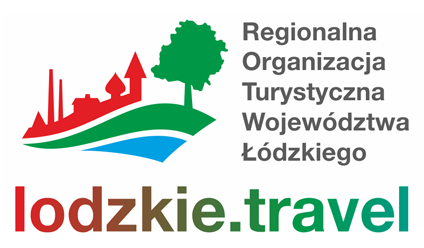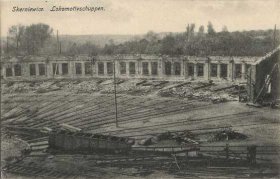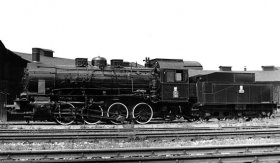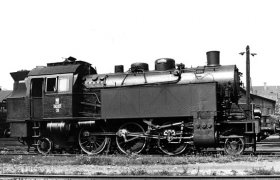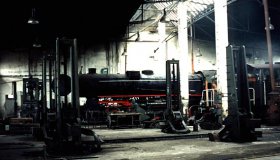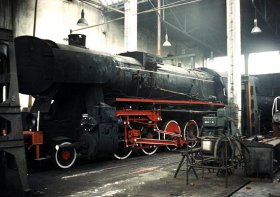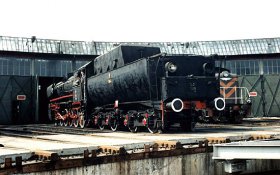The history of the Skierniewice engine yard
Limited capabilities of the first steam locomotives had been forcing the localisation of sheds in several scores of miles and the technical and traffic regards required placing them on junctions. Skierniewice perfectly fit both of these conditions, being located 65 kilometers from Warsaw on the junction where lines to Łowicz and Rogów split, leading towards the border.
Out of the original group of objects only the location (opposite to then-existing platforms of the so-called Tzar Station in nearby gardens) remained unchanged to this day. Unfortunately no plans or descriptions of the shed from 1845 have survived. The first documented mentions are from 1858, when the roundhouse had already been heavily re-built. The ironworks were converted into a hostel and rooms for locomotive and train crews. A new water tower with pumps was erected – this particular object has survived to this day as baths by the bridge over Łupia River. Reports from the same year also mention one engine house and another shed for carriages, one coal depot and a roundtable.
In connection with the opening of the Warsaw-Bydgoszcz Railway (Łowicz – Aleksandrów – Prussian border) and according to the agreement signed with the Warsaw-Vienna Railway on 7th of December of 1861 about the maintaining of the traffic on the way to Skierniewice by the latter (locomotive changeovers and train formation), the shed was being intensively expanded. In 1861 a new 12-meters long roundtable was set up, next year a roundhouse with 8 stands was built (this object was probably the nucleus of the modern roundhouse). Part of the old shed was re-built into flats and offices. 3 years later 4 more stands were added to the roundhouse and in 1871 yet 4 more. Works were continued in 1874-75 and 1879, finishing at the total number of 24 stands. At the same time revision canals, water cranes and waterworks, coal lifts and other devices were modernised, and the coal storage yards were expanded (1868, 1871).
In 1871 water pump station built in 1958 was expanded. The main building had one more section added, 2 more water tanks were set up as well as a new steam engine. It didn’t take too long – 9 years – before it turned out that building a new pump station near the river was necessary. The existing to this day object had two Dupuis boilers and 2 Borsig steam engines with pumps. At the station a new water tower was erected (destroyed in 1914) and the old building was adapted in 1884 into baths for railway workers. It has been maintaining this function for 99 years. This way the western part of the complex was formed and after a few modernisations remains to this day.
Unfortunately there’s no know information on investments at the site of the loco house from 1887-1914 period.
As a strategically important object the shed in Skierniewice fell victim to German mass-damage tactics and theory of leaving a “communicational emptiness” at the enemy’s foreground. On 21th of October 1914 on the order from General Ludendorff all of the buildings and devices were blown up and burnt. Backing off Russian troops devastated the remains and evacuated the rest of the rolling stock, machines and documentation in December of 1914. Nearby location of the front in 1914-1915 would not help any major reconstructions of the shed.
After the war the shed was one of the first objects at the station to be rebuilt. Maintaining a regular railway traffic during the first post war years required quick setting up of workshops overhauling the heavily damaged rolling stock. Since the old Vienna line from the very first days of independence gained serious importance as a main and transitional line, the shed located on the junction of two lines (to Warsaw and Gdańsk) had crucial importance. Skierniewice became a 1st class loco house, operating in freight traffic between Warsaw and Piotrków and serving local passenger trains. It was also a turnover shed for locomotives coming from Kutno.
23 stands wide roundhouse was re-built in the same place where the previous building was located. Some segments of the outer wall along with the lateral walls and office outbuilding located by the track to Łowicz were re-used. Manually driven roundtable was of 16,75m diameter. The dispatcher’s office, crew rooms, small workshop and magazine were located in the outbuilding.
The mechanical workshop was located in L-shaped building situated in the now-square amidst the dispatcher’s office and the roundhouse. The shed’s offices and locomotive crews’ hostel (probably storey) were located eastbound. The coal storage yard of capacity twice smaller than today had a central arrangement with a roundtable for freight cars and 5 radial tracks.
Introduction of the new, better locomotives of Tr21 and Ty23 classes as well as the modernisation of two other sheds in Piotrków and Kutno had been gradually decreasing the importance of the Skierniewice shed. Trains heading to Gdynia and Gdańsk didn’t have to swap locomotives here anymore. From 1925 on the Skierniewice shed officially was only a 2nd class locomotive house.
On 1st of January 1934 the shed in Skierniewice held 35 locomotives and a year and a half later this number decreased to 26. In 1939 it was already an auxiliary unit with only 16 locomotives of Od2, OKl27, Ti4, Tp2 and Tp4 classes, serving local passenger trains, pick-up freight trains and shunting. The workshop carried only periodical mechanical reviews and minor repairs.
Unexpectedly, with the beginning of the Second World War, the sudden need of development of the shed became evident. The war had changed directions of traffic and affected the situation of the rolling stock. On the preparations to German aggression on Soviet Union and especially during it, the freightage rapidly increased on parallel lines. Moreover, some of the eastbound transports from Silesia were being sent to Warsaw via Skierniewice. The locomotive house had to be adapted to maintain heavy freight locomotives (of German class 58 and Polish class Ty23, and prospectively 52 and 42 classes) and carry overhauls as well as on the spot defect repairs (very frequent under war conditions).
The modernisation started at the end of 1940 with expansion of coal storage yard in order to gain independence from infrequent coal supplies from Silesia. Two concrete yards capable of holding 9000 tons of coal were set up and equipped with 3 mechanical lifts of Teudtloff system. At the same time the roundhouse was also expanded. The roundtable was replaced with a new one – 20 meters long. The outer wall of the roundhouse was moved back do achieve 27 meters long stands, capable of housing the longest locomotives in service. A new machine house with the workshop and social building, including smithy and pan foundry and baths and locker room upstairs was built.
In 1942 on the site of the former mechanical workshops two new buildings were erected: spare parts store and storey house with offices, cantina and hostel. Other investments included new power supply, sand drying facility, cleaning canals with bridge cranes for ash removal and water cranes ( see the map ). A triangle of tracks was built on the side of Bielańska Street so the locomotives would have been turned around even when the roundtable at the shed was out of order.
All buildings were built from red brick in modernistic style, using normalised projects prepared by the General Direction of Eastern Railway in Kraków. Behind the roundhouse, where garages are now located, wooden barracks housing ironworks and boiler workshop were raised. It’s possible that initially they served as hostels for builders.
After the modernisation the shed in Skierniewice hosted 50 locomotives, mostly of freight class 58 (Polish Ty1), subsequently replaced with Ty23. Local passenger trains were carried by old Prussian class 13 (Polish Pd5).
In the first years after the war not much was happening happening in the shed. Only the triangle of rails was liquidated. The workshop maintained ongoing repairs, revisions and middle repairs of steam locomotives and ongoing repairs of cars. Building the line to Łuków (1954) and increasing number of transit transports going from the West to the East were the reasons to move the heaviest Polish locomotives of class Ty51 to Skierniewice. In 1957 the shed housed 22 of them. Since the early sixties the amount of work had been constantly growing. The number of “stockers” (as Ty51’s were often called) increased to 36 in 1961 and 40 in 1965 (the shed housed 56 locomotives at the time). Because of that a number of modernisations had to be carried out. First of all, a new 23-meters long roundtable of 250 tons capacity was set up. In the roundhouse the wooden roof construction was changed to steel with triangle-shaped roof ridge skylights. On the north side of building welding shop was built in 1964 along with compressor shop in 1966. On the eastern side another workshop was added in the same year. After drilling deep wells near the water tower only the heating boilers for the baths were used in the old pump house. The Łupia river mouth was no longer used and slowly turned into ruin.
After the electrification of all lines joining together in Skierniewice the shed held only lighter locomotives driving pick-up trains and shunting – Ty2, Tr203 (and also OKl27) classes. The shed had specialized in repairs of steam locomotives carried out for Central Territory Direction of Polish Railways (CDOKP) as well as industrial locomotives (being the only workshop at the territory capable of doing middle repairs). The workshop was capable of overhauling over 70 locomotives per year. In 1970 came the first diesel locomotive from Kutno.
Year of 1980 brought an important change in work organization in Skierniewice. Along with building another track to Skierniewka traffic post it was necessary to change location of the roundtable. Since the actual movement of its axis and rearrangement of the tracks in front of the roundhouse was not possible, a non-standard solution was used. The roundtable was converted into a sort of sectional roundtable with an incomplete angle of movement.
In 1983 begins another period of modernisations at the site of the shed, which lasted for a couple of years. It was connected with the need of adjusting the shed to new types of locomotives. The modernisation caused serious changes in the original look of the buildings. At the same time the ground in the area was toughened and fenced. Garages for automobiles were built along with a new lodge. Laboratory of oils was opened in old baths in 1988. Wooden entrance doors of the roundhouse were replaced with steel-made ones. Front elevations built from face bricks were unfortunately painted over. Next year began the electrification of the way to the roundtable and channel number two (at present the traction is no longer set up).
In fact electric locomotives were already based in Skierniewice slightly earlier – in the middle of 1987 the shed had 15 ET21 class electric freight locomotives, but at the end of 1988 some of them were replaced with newer class of ET22. Diesel traction was represented mainly by SM42 class. In spite of that Skierniewice no longer served transit and long distance trains. All locomotives were used only for minor jobs, shunting, pick-up and service freight trains. In 1991 there were only 24 machines in the inventory. 1989 marked the end of steam in Skierniewice.
Gradually decreasing amount of work resulted in attempts to find additional jobs. The modernisation of the workshops for repairs of modern rolling stock from various sheds was continued along with the production of spare parts. The shed was doing overhauls and adaptations of cars for traction service trains. Middle repairs were continued for steam locomotives from CDOKP. Unfortunately – the number of locomotives exceeding the actual amount of work for them, still lowering freightage and close location of other large sheds in Warsaw, Kutno, Łódź i Piotrków ended the hopes for development or even survival. On 31st October of 1991, after 146 years the Skierniewice engine house ceased to exist as an organisational unit. Until the liquidation of devices and equipment the shed was assigned to Warszawa Odolany shed as an outside section.
When the end of the work in the Skierniewice shed was doomed, Polish Association of Railway Enthusiasts (PSMK) took the initiative of creating the base for relic rolling stock belonging to PKP right there, at the oldest survived engine house of the Warsaw – Vienna Railroad. The great anniversary of 150 years of railway on Polish territory was getting closer. Because of financial reasons PKP passed on running the shed, now threaten by physical liquidation or, in best case, rearrangement for purposes not connected with railway.
In this situation PSMK undertook the task (not without the help from CDOKP and General Direction of Polish Railways) of preserving the shed as a museum of railway including working rolling stock and collection of relics. Unfortunately, not all devices were saved from scrapping or moving to other units.
In the meantime grew the collection of exhibits obtained by PSMK – old locomotives and coaches that were waiting for scrapping in different parts of the country. Along with them a number of old semaphores and other devices was acquired. The site of the shed was cleaned up and prevented from further destruction. Damages caused by acts of vandalism or visits of uninvited guests were also made up. In 1994, thanks to the efforts of PSMK and understanding from conservation services the entire complex of engine house was entered into the Polish Register of Relics. After then the formal liquidation of the shed, which went on since 1992, actually stopped.
At the end of December of 1992 CDOKP made PSMK an offer to overtake the useless for PKP complex. After two weeks of consideration PSMK agreed to the proposal, and CDOKP put things in motion for the innovatory project. Procedures turned out to be much more complicated as they initially seemed. Despite the generosity of all sides taking part in transferring the object, all actions took nearly 10 years. On 8th of November 2002 PSMK finally became the official owner of the Skierniewice engine house complex.
The future of this historical formation of objects is connected with preservation and promotion of Polish railway heritage, achieved by gradual revaluation of relic buildings and objects as well as organisation of the exhibition of old rolling stock and various railway devices. We would like that this shed, which has been a major part of this region’s cultural landscape for 150 years, remained its important and alive element.






